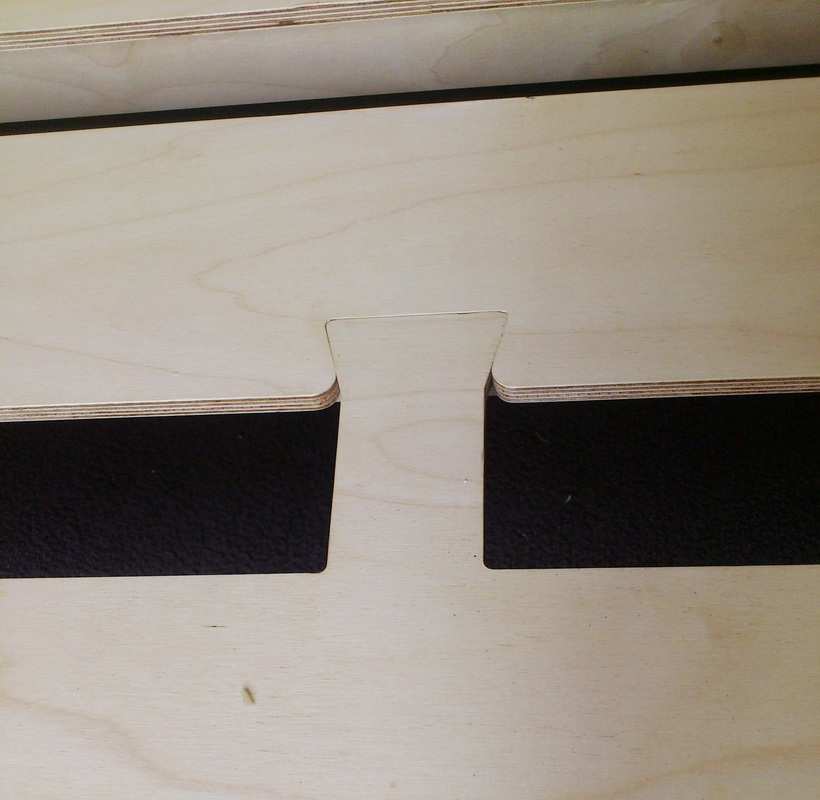|
Plywood has a property that is very useful indeed for ensuring your pieces are rigid: it doesn’t have a preferred grain. If you wanted an ‘L’-shaped section using solid wood, you would need to fashion two pieces and join them together. With any joint, there is inherent weakness: it’s weaker than if it were a single piece. With plywood of course, you can make this a single piece as it’s a sheet material. In addition, plywood is comprised of multiple layers, each layer having a grain that is perpendicular to that of the layer above and below it. By my reckoning, it means that an ‘L’ shaped piece cut out of a plywood sheet must be about as strong as having two strips of solid wood joined together using the strongest joint possible. It seems to me that when working making an ‘h’-shape with solid wood you need at least two joints. Chairs which include this as part of their design often have extra bracing members between the front and rear legs for extra stability. When I was designing my second plywood chair, I decided to challenge my thinking as to how thin the ‘h’-shapes in the frame could be, particularly around the intersections and corners. The thickness I chose was about 45mm, which I was not sure was going to be wide enough but I needn’t have worried - it is easily sturdy enough, and I possibly could have gone narrower. I avoided joints there for the ‘h’ sections of the chair frame where using solid wood would have required them, but of course there are joints at other points of a plywood chair designed to be cut using CNC. This leads me onto the other aspect of achieving rigidity - how to efficiently ensure there is no wobbling, warping or changing shape. I wanted my chairs and couch to be strong in resisting any reasonable attempt to force them out of shape. There a few ways to try to explain this using the chair as an example - choose the one which makes sense to you:
A good way of showing how I did this is by looking at the frame of my couch. Firstly at the seat level. There are beams under each slat, attached using a dovetail catch (refer to a previous post about dovetail catches), and therefore the beams can’t move sideways with respect to the slat. So if the slat is prevented from moving sideways then so are the beams. It just takes two immovable horizontal beams to create rigidity in the seat, so I just have to ensure one slat can’t move sideways relative to just one other slat. The way I’ve done that is by shaping the front-most slat to include an arm which protrudes into a cavity in the middle slat: Incorporating a perpendicular arm, making it into a ‘T’ shape, is only strong enough in a material which has grains in perpendicular directions like plywood, so I’m using that to good effect here. A similar design for achieving rigidity is used in the back of the couch. I have used two protruding arms here for symmetry but it strictly only needs one. Now that the slats can’t move out of alignment with each other it also means that the vertical “poles” of this couch are locked into their position - they can’t sway sideways because the beams, attached to the slats again using dovetail catches, will prevent them. With these two systems in place, the only other way a couch could warp/twist/bend out of shape is if the seat/back sway forwards or backwards. The way this is prevented is by the simple choice of having the sides of the frame be one ‘h’-shaped piece. In this case, it’s a bit of a stylised ‘h’ of course. This is the thought process I’ve gone through to make myself comfortable that the pieces I’m designing will sturdily keep their shape. I wanted to be able to push/pull on any corner of the couch and see it retain its shape well, and it I’m happy to say this is the case. When it is time to vacuum the room, I pull on the back of just one of the armrests and the whole couch towards me without twisting/warping in the slightest.
Comments
|
AuthorI'm Nicolaas, a software engineer with a creative streak. ArchivesCategories
All
|







 RSS Feed
RSS Feed